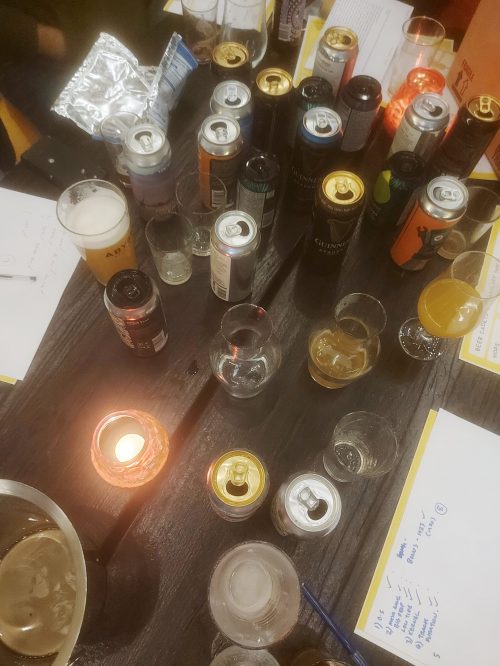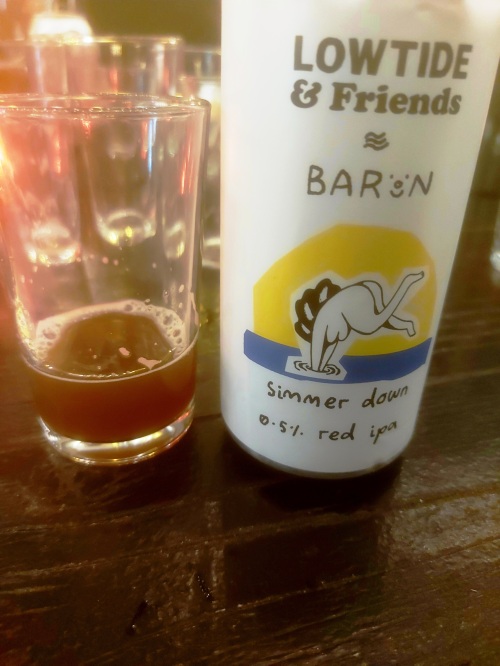As a perennially knackered post-pandemic fifty-something parent, I don’t go out much. But I did have a fun evening a few weeks back, tempted down to my local brewery and taproom, Abyss, for an educational, entertaining session sampling low alcohol beers. This was one of Abyss Beer Cadets sessions, led by the knowledgeable, enthusiastic Ellie King (@hoppy_raptor).
Things have really progressed recently, with the low and no-alcohol beer market exploding and breweries like Athletic, Big Drop, Mash Gang and Low Tide specialising. Specialism has really pushed things forward from the dark days of the only low-alcohol beer being dreadful lager. These breweries are toiling to create beers as notable and varied those we’ve been seeing the past twenty years or so since the craft beer scene really took off.
It’s still a very hit and miss area though. Some of the lagers seem OK (though I’m not a lager drinker), but many of the offerings are still underwhelming. We didn’t drink it with Ellie, but Brewdog’s Nanny State is one such failure – it has some malted rye giving it a cherry-inflected sweetness, but it has no body, no mouthfeel and very little aroma. It’s watery and bafflingly poor for such an assertive brand.
Standout beer
To date, the low-alcohol ale I’ve enjoyed the most has been Clear Head by Bristol Beer Factory. But the brewery that came out tops in the Beer Cadets session was from Lowtide Brewing Co, in Bath. This is a young organisation, which started life when cousins Dave Brown and Rob Buchinger-Jones set up an online shop for low and no-alcohol beers. This quickly morphed into founding an actual brewery. Considering they’ve only been brewing for a few years, it’s impressive. Their Forgot to take my Pils was a decent lager, but for me – and for most of the rest of us at the Beer Cadets session – Simmer Down made the best impression.
Simmer Down, made by Lowtide and Baron Brewing in Hertfordshire, is a red IPA. Now, I’ve got a sold spot for red ales and milds and things like that, with body, a distinctive colour and malts sharing the stage with the hops. So many craft brewers in the UK seem afraid to be more malt-forward. I guess it’s just trends. This one didn’t disappoint.
Simmer Down is 0.5% ABV drink, but while it’s a bit thinner than many full-fat ales, it has a decent head and some complex flavours, apple, caramel, bitterness. It’s hopped with Citra, Cascade, Mosaic and Centennial as well as Cryo Pop, a soluble “hop blend with the power to add a true ‘pop’ of aromas and flavors in beer” made by Yakima Chief. I can’t get my head around the technical aspects of brewing low alcohol beers (yet), but I do get the impression that a certain amount of science – like the work to produce Cryo Pop – is involved, more so than traditional brewing, something humanity has been playing with for at least 10,000 years, and perfecting since we started permanent settlements and arable farming.
Heritage speritage
A week after Beer Cadets I was out for a family meal in a Marstons pub in Exeter. There, the only low alcohol ale they had on offer was, confusingly, called Low Tide. It was branded for an ostensible craft brewery in the states, Shipyard. Interestingly, on the US Shipyard site they say they are “a family owned brewery based in Portland Maine for over 25 years”. Yet the bottle of Low Tide I had, despite carrying the same heritagey branding, was clearly marked as “Brewed and bottled in the UK by Carlsberg Marston’s Brewing Co Ltd.” Yes, the venerable British brewer (founded 1840), sold its assets in 2020 (founded 1847), forming the aforementioned Carlsberg Marston’s Brewing Company. At least when Shipyard reiterate the spiel about “family owned” on the UK site, the footer is clear about the ownership. Despite the obvious irony.
Funny really, it doesn’t matter when you were founded, as for me, growing up, Marston’s was generic ale, and Carlsberg has always been synonymous with generic, industrial lager. They might own all these breweries around the world, but this multinationalisation, conglomeratisation (probably not a word) just seems to destroy distinction, whatever the branding. This is a tragedy played out across the world – craft breweries and small historic breweries are subsumed, their product neutralised.
I’d be intrigued to try a Shipyard ale brewed in their Portland brewery and drunk in their taproom, as this Carlsberg Marston’s offering was just forgettable, all that’s offputting about low-alcohol beer: thin, watery, no body, very little head, minimal scent, very little flavour. Sure, it washed down a chain-pub scampi and chips dinner OK, but there was simply nothing interesting to report about it. Apart from the fact that its naming caused a moment of confusion with the far better quality low alcohol beer I’d drunk the week before, proceeded to order a case of, and am drinking tonight. Thanks Ellie and Abyss for introducing me to it.
PS. Please forgive the photography. Phone camera is broken. Trying to get a new phone, but my laptop is dying too.

































